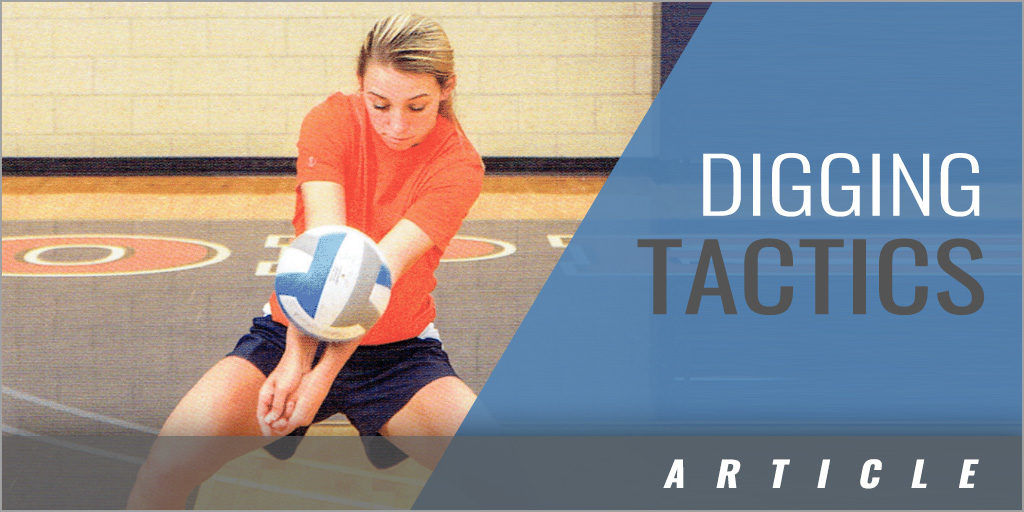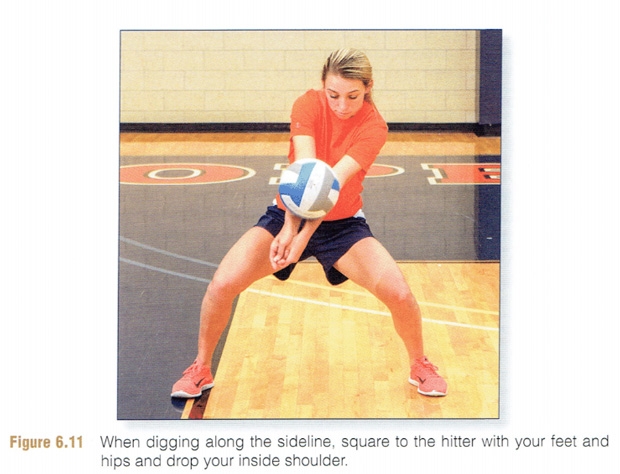|
By: Becky Schmidt Originally Published in: Volleyball: Steps to Success Provided by: Human Kinetics Being a good digger means having solid technique but also an acute awareness of what is happening on the court and what may happen. The art of reading hitters is developed through practice and game experience. READING HITTERS Some defenders look impressive because they dive around the court making spectacular saves. The best defenders, however, seldom have to dive because they can predict where the ball will go and put themselves in a balanced position to play the ball with control. These diggers are skilled at reading the opponent's offense and an entire book could be written about that skill alone. For the beginning volleyball player, here are a few things to watch that will help you read the hitter and predict where she will attack. Angle of Approach Most volleyball hitters tend to hit in the direction that they approach. If their approach is angled sharp to the set, then they will attack sharp crosscourt. If their approach starts inside the court and goes toward the sidelines, they will tend to attack the line. Identify the hitter's starting position and put yourself on the same extended line of where they are approaching. Set Location in Relationship to the Block The block creates a shadow of space on the court to which it is impossible for a hard-driven ball to be attacked. When you find yourself in that space, move to an area that can be attacked or commit to covering the tip over the block. Plant in Relationship to the Ball Many hitters give away where they are going to attack by how they plant to the ball. For instance, if a hitter jumps to attack and the set falls short of her body, then she will almost always have to attack crosscourt. Likewise if she plants too far inside, then the only shot open is the line. Elbow Hitters with powerful arm swings use a high elbow to contact the ball hard and fast, but in order to tip a ball, contact must be made below the ball to avoid the block. Watching the hitter's elbow is an important cue for predicting her intentions. If you see a hitter's elbow drop and her hand move under the ball, then it is likely she will tip the ball shallow in the court. Tendencies While thinking about the tendencies of a hitter isn't necessarily reading what is happening on the opponent's court, you should keep a mental note of what opposing hitters have tried before. If it was successful, they might continue to exploit the strategy until you make an adjustment. Sometimes hitters have only one shot in their arsenal. The challenge with novice volleyball players is that because of inconsistent technique and hand contact, they are sometimes harder to read than advanced players. The best advice is to put yourself in a position that keeps the court in front of you and to remain stationary at contact so that you can react to wherever the ball goes. Misstep You move into position while the ball is being contacted. Correction Be stationary at contact even if you are sure you know where the ball will go. A last-second redirection with the wrist, a mishit, or block deflection could cause the ball to react differently than you predicted. To then stop, change direction, and pursue the ball will almost always make you late to playing it. DIGGING TARGET As we established earlier, you want to dig a ball to a different location than where you pass a ball in serve receive or off a free ball. A higher dig is better than a lower dig, a ball dug off the net is better than a ball dug too tight, and a dig to the middle of the court is better than a dig to the sidelines. A perfect dig is one that is passed 15 to 20 feet (4.6-6.1 m) in the air, 7 to 12 feet (2.1-3.6 m) off the net, and near the middle of the court. To dig with consistency, keep the following considerations in mind. Line Digging When you are digging along the sideline, square up to the hitter with your feet and hips, and drop your inside shoulder so that the ball will redirect to the middle of the court (figure 6.11). Because you usually will be responsible for digging the hard-driven ball and the tip, you should be in a position that allows you to easily move forward as well as get your hands up to dig overhead.
Seam Digging When you are positioned in the middle back, square to your hitter and drop your inside shoulder (when the attack is coming from the pin), but to a much lesser degree. It is important for the seam digger to keep a narrow base because of the necessity to pursue balls that deflect off the block or are attacked to the deep corners. Crosscourt Digging The crosscourt digger is generally both squared to the hitter and target area, but that doesn't mean his job is easier. Make sure you get all the way to your line to keep the court in front of you and be ready to use the collapse digging technique to play balls that are attacked in front of your feet. Off-blocker Digging As an off-blocker, you are primarily responsible for defending two specific shots. One is the off-speed ball played to the middle of the court that you will play with your forearms. The other shot is the sharp crosscourt attack that you will play with the overhead digging technique. Regardless of which shot you play, the most important adjustment you need to make is giving enough height to the dig that you have time to complete the skill and transition out to your hitting position. This will also ensure that despite the shallow attack, the other hitters in the front row will also be able to transition effectively. Misstep You do not get high enough on your line in defensive positioning. Correction By putting yourself on your line about 12 feet (3.6 m) from the net, even if you have to make poor contact with the ball, you have teammates close enough to pursue the ball. When you are too deep and make a poor contact, the ball will usually ricochet in a direction where no one else is in position to play it. PARALLELS The most vulnerable place in any defense is the seam between two players' responsibilities. When a ball is attacked into this seam, the player who is closer to the net will, generally, take the ball hit shallow and the player farther away should play the ball hit deeper. Both players should go for the ball because movement will be required before they know exactly whose ball it is. Understanding their responsibilities will help them know which balls to play. PLAYING THE DEEP ANS TIPPED BALLS The never-ending struggle in defensive positioning is how to play the hard-driven deep ball and cover the tip. Proficiency in the overhead digging technique allows you to take a more shallow defensive position that will reduce the distance you will have to move to cover the tip. Make sure that your weight is always on the balls of your feet and that at contact you are stationary and have a narrow base in order to react and move to where the ball is played. |








